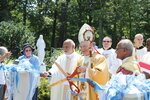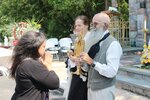

NASONVILLE — Former Auxiliary Bishop Robert C. Evans celebrated Mass for a large group of the faithful in commemoration of the 100th anniversary of the Shrine of the Little Flower — the oldest shrine dedicated to St. Therese in the United States and the second oldest globally — on August 20.
“Heavenly Father, we come to You with confidence and love in this centenary year of our Little Flower Shrine. You so often chose the little and the weak to show forth Your great Power and Love,” Bishop Evans prayed.
More than 200 lay faithful, clergy and religious gathered at the outdoor altar on the lawn adjacent to the parish building. Those present came primarily from the Diocese of Providence, though faithful, clergy and religious from places as far away as New Hampshire, California and the Midwest were also in attendance.
Father Jose Parathanal, C.M.I., the pastor of the Shrine of the Little Flower, concelebrated the Mass, along with Father Cyriac Kalampatt, C.M.I., associate pastor; Father Joseph Mappilamattel, the associate pastor of St. Thomas More Parish in Narragansett; and Father A.C. Perianayagam, the assistant pastor of Sacred Heart Parish in East Providence.
In his homily, Bishop Evans emphasized the centrality of humility and trust in God in the life of the believer, something which was exemplified with particular profundity in the life of St. Therese of Lisieux.
“Why does the Church give us saints? The Church gives us saints not because they were perfect, or because they never sinned, or they never knew suffering. If so, they would have never been human. The Church gives us saints so that we can be encouraged by the example of men and women like ourselves who are able to accomplish great things because they trusted God,” Bishop Evans preached.
The bishop noted how St. Therese of Lisieux did not take part in extensive missionary work, nor did she hold a high-ranking position in the Church, but rather attained a high level of holiness through what she described as “the little way” — rooted in the maxim “Do small things with great love.”
Bishop Evans noted that the approach to spiritual and moral life has deep biblical roots, in Matthew 18:4, in which Our Lord says, “Whoever humbles himself like this child is the greatest in the kingdom of heaven.”
Bishop Evans concluded by encouraging Catholics to learn to “rely on God, and not on ourselves, and not on the things of this world, for the true meaning of life.”
After Mass, Father Parathanal presented a crystal plaque to Bishop Evans in commemoration of the 50th anniversary of his priestly ordination. The bishop then presented gifts to the event organizers and to those who assisted with or donated to the expansion of the outdoor shrine.
Bishop Evans led a ribbon-cutting ceremony for the beautiful new Rosary Walk constructed on Shrine grounds. The Rosary Walk consists of a series of 10 brick structures with stone tablets on both the front and back containing images of the mysteries of the Rosary.
Each station is adorned with a small garden. The construction of the Rosary Walk was first suggested by Father Parathanal. David Lamontagne, a local artist and owner of a renovation company, and parishioner at the Shrine of the Little Flower, designed the stone tablets and oversaw the construction of the Rosary Walk.
Indian musicians playing the chenda, a type of percussion instrument common particularly in southern India, accompanied the ribbon-cutting ceremony. The performers were from St. Thomas Parish in Boston, an Eastern Catholic parish of the Syro-Malabar rite, which traces its origins to India. After the ribbon-cutting, Bishop Evans blessed the Rosary Walk, and each individual station.
Father Parathanal and Bishop Evans lead those present in a Rosary procession. After lunch, Eucharistic Adoration and Benediction accompanied by the recitation of the Divine Mercy chaplet, the Stations of the Cross and the Holy Stairs devotion.
St. Therese died in 1897 and was beatified 25 years later in 1923 by Pope Pius XI. Even in the early days of her canonization process, St. Therese had devotees among the Catholics in Rhode Island, particularly among those of French descent, and devotion to this saint was so strong that the year she was beatified, Most Rev. William A. Hickey, Bishop of Providence, approved the building of a parish dedicated two years before St. Therese’s canonization.
In 1923, the year the Shrine opened, a group of nuns stationed at the parish visited a parishioner, Florilda Faford, who had been suffering a series of debilitating and incurable diseases for years. After the nuns prayed a Novena with Mrs. Faford, she was reported to have been healed.
Attributing her recovery to the intercession of St. Therese, Faford traveled throughout the local communities telling her story and attempting to raise money for the construction of a statue of St. Therese to be erected at the Shrine.
Over the next several decades, pilgrims from throughout the world would travel to this shrine, and a large number of those present claimed to be miraculously healed from their ailments.
Many of those present attested to the spiritually profound nature of the day’s events.
“It was beautiful,” said Doreen Nanni, a parishioner at the Shrine of St. Therese for the past 31 years, of the ceremonies of the day. Nanni was one of those honored for donating to the Rosary Walk. She said that her contribution was born out of a deep respect for St. Therese’s spiritual philosophy, believing that one way to live it out is by living a life of gratitude.
“I have an affinity for St. Therese’s mission, in that you do little things with great love. … I felt that we’ve been blessed with many things; life takes a lot of different twists and turns, and by God’s grace we get through.”
The Rosary Walk serves as a perpetual sign to the world of God’s constant presence and our devotion to Him. “In today’s world, we need these examples,” Nanni continued.
“It was very spiritual for me,” said Jackie Dionne, a parishioner at the Shrine who helped to design the gardens surrounding the Rosary Walk. “It was very enlightening for me to get involved. … There were so many people involved, and it all came together beautifully, from the decorating to the organizing.”
For David Lamontagne, the prayerful aspect of the anniversary observance was most meaningful.
“It’s wonderful to be able to get together as a Catholic community and pray. For me, that’s the core. That’s the source of my peace: prayer,” he said.